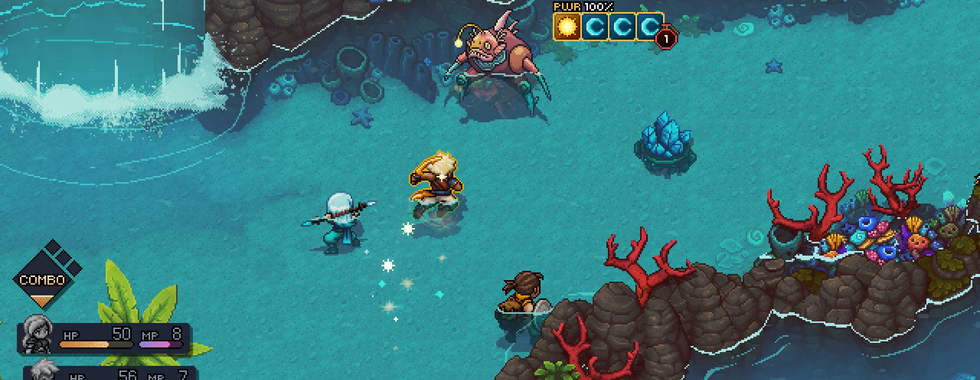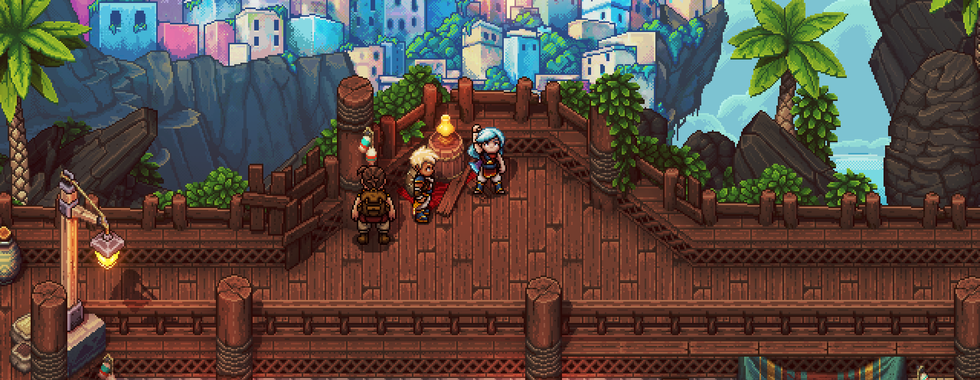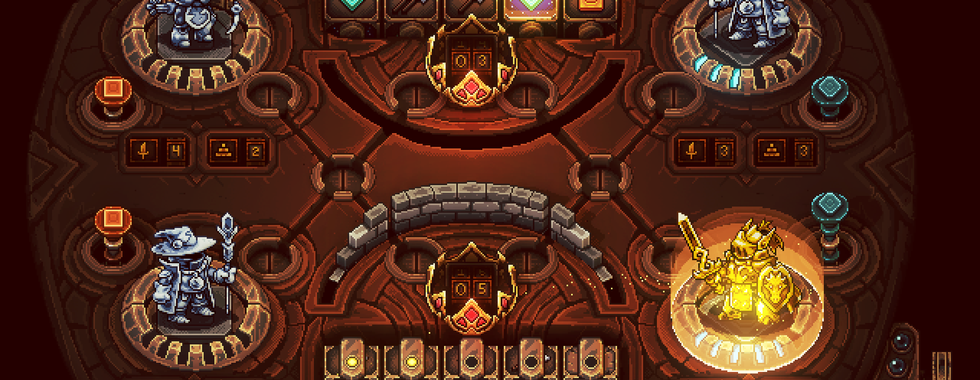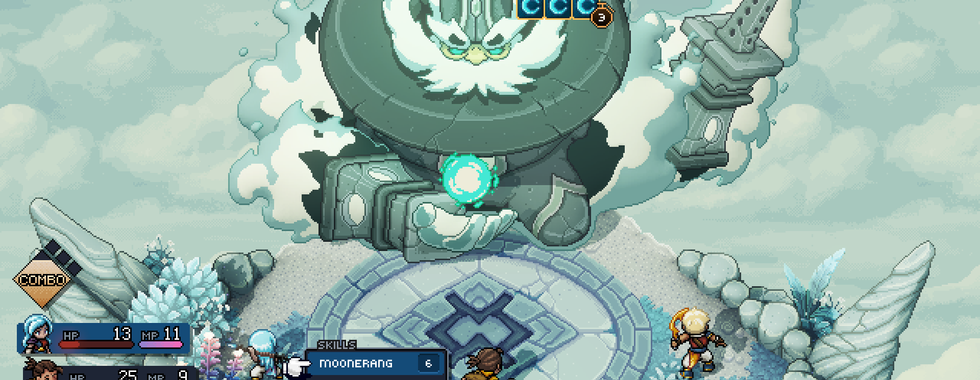Sea of Stars Review
- Mekel Kasanova
- Aug 28, 2023
- 6 min read
Initial Release Date: August 29, 2023
Developer: Sabotage Studio
Composers: Yasunori Mitsuda, Rainbowdragoneyes
Genres: Role-playing video game, Indie game, Adventure game, Adventure
Mode: Single-player video game
"Review Copy Provided By Sabotage Studio"
Approximately half a decade ago, Sabotage captivated audiences by releasing The Messenger, a distinctive and inventive action platformer that stood out amid a flood of similar retro-themed indie titles. Encouraged by the well-deserved success of that game, the team embarked on their dream venture, a retro-styled JRPG titled Sea of Stars, inspired by iconic games like Chrono Trigger and Secret of Mana. Although there were skeptics who questioned the studio's capability to deliver a divergent experience from their initial offering, it is gratifying to confirm that such skepticism can be firmly laid to rest. Sea of Stars not only fulfills all expectations but also executes its vision almost impeccably, offering players an enjoyable, immersive, and outstandingly well-crafted addition to the JRPG category.
The narrative of Sea of Stars begins in an age-old library, where an enigmatic archivist narrates a tale set in the same universe as The Messenger, albeit millennia prior to the events of that game. A malevolent deity known as The Fleshmancer conjured several monstrous beings called Dwellers before vanishing. Each of these creatures had the potential to transform into a World Eater and trigger an apocalypse if allowed to reach adulthood. To counter this threat, a formidable order of mage-warriors named Solstice Warriors was established to eradicate the Dwellers, who are susceptible to magic during an eclipse.
The story introduces our main protagonists, Zale and Valere, at a point when only one Dweller remains to be vanquished, although the ranks of the Solstice Warriors have diminished to a mere trio. Consequently, Zale and Valere are enlisted at a tender age to master their innate affinities for solar and lunar magic, culminating in a quest to eliminate the final beast and thwart The Fleshmancer's nefarious schemes.
Similar to The Messenger, the storyline of Sea of Stars encompasses much more than initially meets the eye, and it is a true pleasure to witness its unfolding and gradual expansion. Despite a somewhat languid beginning, Sea of Stars boasts a remarkably well-crafted narrative that adeptly balances gravity and humor. Overall, it exudes a darker and more intense ambiance than the prevailing lightheartedness of Sabotage's debut, yet it includes numerous instances where the studio's characteristic dry humor is evident. Crucially, Sea of Stars excels in developing the relationships between the main characters, particularly Zale and Valere. Players will become deeply invested in the trials faced by this group throughout the approximately 30-hour duration required to complete their journey, and the emotional moments will resonate profoundly when they occur.
Sea of Stars adheres to the conventional JRPG format, inviting players to traverse a vast world filled with hidden treasures and dungeons, engage in turn-based battles with adversaries, and assemble a progressively expanding party, each member having a unique role in both combat and the storyline. The influence of classic SNES JRPGs is palpable throughout, yet Sea of Stars assimilates and enhances their concepts. For instance, the game world is remarkably interactive for a retro RPG. If a ledge or rooftop appears climbable, it likely is; players are not confined to a rigid, grid-like movement area that restricts their options.
The exploration experience closely resembles what one would anticipate from a contemporary installment in the Golden Sun series, with all dungeons and locations teeming with novel environmental puzzles and thoughtful design that transcends the sensation of merely traversing distinctively adorned passageways that guide you to the subsequent narrative event. In fact, dungeons exhibit a traditional Zelda-like structure, typically featuring a newly acquired gadget or magical ability halfway through that grants additional traversal options and 'unlocks' the remainder of the dungeon while also providing new tools for exploring the overworld and discovering additional rewards and unlockables during backtracking.
Encounters with enemies initiate battles directly at the point of contact and adhere to standard turn-based mechanics. Each foe has a counter displayed above them, indicating the time remaining before their next attack, occasionally accompanied by a small box containing icons. These 'Locks' correspond to various elements and weapon categories wielded by your characters. Successfully targeting an enemy with the appropriate attacks before their counter reaches zero will nullify their attack entirely. Even if not all locks are targeted in time, each one successfully hit will reduce the enemy's strength by a fixed percentage.
Drawing inspiration from Super Mario RPG, both offensive and defensive actions can be augmented by precisely timed inputs that either amplify your damage or diminish the damage received from opponents, adding a layer of engagement to the battles. The necessity to master the timing for new enemies or attacks prevents complacency and introduces a skill-based element to the fights, beyond merely optimizing characters with suitable statistics and letting the numbers dictate the outcome—you must actually improve your combat skills against a boss if you repeatedly lose.
Furthermore, a boost system, loosely reminiscent of Octopath Traveler, is incorporated. Landing standard attacks not only generates MP for executing more potent combos but also disperses a barrage of magical orbs across the field, available for utilization. To enhance the impact of an attack or a party buff, a character can absorb the orbs, up to three times per action, to increase its potency.
As a result, battles are much more intricate than merely selecting options from a menu, and this dynamism infuses each encounter with significance. In a departure from conventional RPG design, even the low-level, common enemies encountered during exploration can inflict substantial damage and potentially incapacitate characters in two or three hits, even with appropriate gear and levels. This implies that auxiliary systems like attack augmentation and input timing are relevant beyond just boss encounters, ensuring that combat engagements never feel like tedious filler.
In a notably progressive design decision, characters do not level up individually. Instead, the entire party accumulates experience and advances as a single entity, with each member (including those not actively participating) receiving a proportional increase in statistics upon leveling up. Although players retain some control over individual development by selecting a specific statistic to receive additional points during leveling up, this approach eliminates the 'bench' commonly found in most RPGs. Every party member, even newly recruited ones, is combat-ready and on par with the others. Although only three characters can participate in a battle at any given time, any of them can be substituted by a party member on the sidelines without forfeiting a turn. This promotes the utilization of the entire party consistently, rather than exclusively relying on a select few while neglecting the rest.
Many esteemed JRPGs include a minigame that can be played throughout the game, and Sea of Stars is no exception, featuring the entertaining 'Wheels' game, which can be played with patrons in the taverns you visit. Essentially, Wheels is a dice-rolling game where the objective is to deplete your opponent's HP before they deplete yours. Each match commences by selecting two characters, such as a mage and a knight, who will perform their action once they accumulate sufficient energy, generated by your rolls. Players are allowed three rolls per turn, with each of the five wheels producing a symbol corresponding to one of your characters or a barrier that can be constructed to block damage.
The strategic aspect of Wheels lies in the ability to selectively lock wheels that you wish to retain. For example, if you desire your knight to attack during a turn, it would be advantageous to lock any symbols corresponding to the knight. However, on this exceptional piece of work. A unique blend of retro and modern aesthetics, Sabotage Studio’s sophomore effort is a masterclass in game design and storytelling, demonstrating that the indie developer is not a one-hit wonder, but a force to be reckoned with in the gaming industry. The game not only pays homage to the classics that inspired it but also brings fresh ideas to the table, making it an essential play for both fans of the genre and newcomers alike. Whether it's the intricate combat system, the memorable characters, the captivating narrative, or the beautifully rendered pixel art, there's something in Sea of Stars for everyone to appreciate.
Sea of Stars is a triumphant success for Sabotage Studio, effectively capturing the magic of yesteryears while injecting it with a dose of contemporary innovation. The end result is a game that feels both familiar and novel, a timeless adventure that will surely be remembered as one of the highlights of the modern indie gaming scene. Don't pass up the opportunity to embark on this unforgettable journey.
















































































Comments